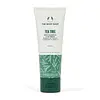What's inside
What's inside
 Key Ingredients
Key Ingredients

No key ingredients
 Benefits
Benefits

 Concerns
Concerns

No concerns
 Ingredients Side-by-side
Ingredients Side-by-side

Water
Skin ConditioningKaolin
AbrasiveGlycerin
HumectantCaprylic/Capric Triglyceride
MaskingPropanediol
SolventCetyl Alcohol
EmollientArachidyl Alcohol
EmollientButyrospermum Parkii Butter
Skin ConditioningBehenyl Alcohol
EmollientArgilla
AbrasiveAcrylates/Beheneth-25 Methacrylate Copolymer
Phenoxyethanol
PreservativeXanthan Gum
EmulsifyingArachidyl Glucoside
EmulsifyingCalophyllum Inophyllum Seed Oil
AntimicrobialCaprylyl Glycol
EmollientMelaleuca Alternifolia Leaf Oil
AntioxidantCoco-Caprylate/Caprate
EmollientSalicylic Acid
MaskingTriheptanoin
Skin ConditioningSodium Hydroxide
BufferingMenthol
MaskingTrisodium Ethylenediamine Disuccinate
C9-12 Alkane
SolventDilinoleic Acid/Butanediol Copolymer
Limonene
PerfumingCitral
PerfumingLinalool
PerfumingCastor Oil/Ipdi Copolymer
Citronellol
PerfumingLeptospermum Petersonii Oil
MaskingCitric Acid
BufferingTocopherol
AntioxidantCI 19140
Cosmetic ColorantCI 42090
Cosmetic ColorantWater, Kaolin, Glycerin, Caprylic/Capric Triglyceride, Propanediol, Cetyl Alcohol, Arachidyl Alcohol, Butyrospermum Parkii Butter, Behenyl Alcohol, Argilla, Acrylates/Beheneth-25 Methacrylate Copolymer, Phenoxyethanol, Xanthan Gum, Arachidyl Glucoside, Calophyllum Inophyllum Seed Oil, Caprylyl Glycol, Melaleuca Alternifolia Leaf Oil, Coco-Caprylate/Caprate, Salicylic Acid, Triheptanoin, Sodium Hydroxide, Menthol, Trisodium Ethylenediamine Disuccinate, C9-12 Alkane, Dilinoleic Acid/Butanediol Copolymer, Limonene, Citral, Linalool, Castor Oil/Ipdi Copolymer, Citronellol, Leptospermum Petersonii Oil, Citric Acid, Tocopherol, CI 19140, CI 42090
 Reviews
Reviews

Ingredients Explained
These ingredients are found in both products.
Ingredients higher up in an ingredient list are typically present in a larger amount.
Caprylyl Glycol is a humectant and emollient, meaning it attracts and preserves moisture.
It is a common ingredient in many products, especially those designed to hydrate skin. The primary benefits are retaining moisture, skin softening, and promoting a healthy skin barrier.
Though Caprylyl Glycol is an alcohol derived from fatty acids, it is not the kind that can dry out skin.
This ingredient is also used as a preservative to extend the life of products. It has slight antimicrobial properties.
Learn more about Caprylyl GlycolGlycerin is already naturally found in your skin. It helps moisturize and protect your skin.
A study from 2016 found glycerin to be more effective as a humectant than AHAs and hyaluronic acid.
As a humectant, it helps the skin stay hydrated by pulling moisture to your skin. The low molecular weight of glycerin allows it to pull moisture into the deeper layers of your skin.
Hydrated skin improves your skin barrier; Your skin barrier helps protect against irritants and bacteria.
Glycerin has also been found to have antimicrobial and antiviral properties. Due to these properties, glycerin is often used in wound and burn treatments.
In cosmetics, glycerin is usually derived from plants such as soybean or palm. However, it can also be sourced from animals, such as tallow or animal fat.
This ingredient is organic, colorless, odorless, and non-toxic.
Glycerin is the name for this ingredient in American English. British English uses Glycerol/Glycerine.
Learn more about GlycerinPhenoxyethanol is a preservative that has germicide, antimicrobial, and aromatic properties. Studies show that phenoxyethanol can prevent microbial growth. By itself, it has a scent that is similar to that of a rose.
It's often used in formulations along with Caprylyl Glycol to preserve the shelf life of products.
Propanediol is an all-star ingredient. It softens, hydrates, and smooths the skin.
It’s often used to:
Propanediol is not likely to cause sensitivity and considered safe to use. It is derived from corn or petroleum with a clear color and no scent.
Learn more about PropanediolSodium Hydroxide is also known as lye or caustic soda. It is used to adjust the pH of products; many ingredients require a specific pH to be effective.
In small amounts, sodium hydroxide is considered safe to use. However, large amounts may cause chemical burns due to its high alkaline.
Your skin has a natural pH and acid mantle. This acid mantle helps prevent harmful bacteria from breaking through. The acid mantle also helps keep your skin hydrated.
"Alkaline" refers to a high pH level. A low pH level would be considered acidic.
Learn more about Sodium HydroxideTrisodium Ethylenediamine Disuccinate is used to help stabilize a product.
It is a chelating agent, meaning it helps prevent metal ions from binding to other ingredients. This prevents unwanted reactions in products. Metal ions can come into a product via the water ingredient. They are found in trace amounts and are not known to be harmful.
Water. It's the most common cosmetic ingredient of all. You'll usually see it at the top of ingredient lists, meaning that it makes up the largest part of the product.
So why is it so popular? Water most often acts as a solvent - this means that it helps dissolve other ingredients into the formulation.
You'll also recognize water as that liquid we all need to stay alive. If you see this, drink a glass of water. Stay hydrated!
Learn more about Water